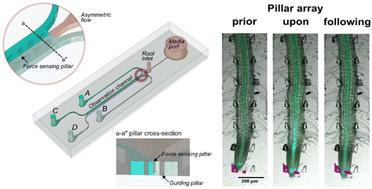Observing root growth and signalling responses to stress gradients and pathogens using the bi-directional dual-flow RootChip
IF 6.1
2区 工程技术
Q1 BIOCHEMICAL RESEARCH METHODS
引用次数: 0
Abstract
Plants respond to environmental stressors with adaptive changes in growth and development. Central to these responses is the role of calcium (Ca2+) as a key secondary messenger. Here, the bi-directional dual-flow RootChip (bi-dfRC) microfluidic platform was used to study defence signalling and root growth. By introducing salinity as sodium chloride (NaCl) treatment via a multiplexed media delivery system (MMDS), dynamic gradients were created, mimicking natural environmental fluctuations. Signal analysis in Arabidopsis thaliana plants showed that the Ca2+ burst indicated by the G-CaMP3 was concentration dependent. A Ca2+ burst initiated in response to salinity increase, specifically within the stele tissue, for 30 seconds. The signal then intensified in epidermal cells directly in contact with the stressor, spreading directionally towards the root tip, over 5 minutes. Inhibition of propidium iodide (PI) stain transport through the xylem was observed following salinity increase, contrasting with flow observed under control conditions. The interaction of Phytophthora capsici zoospores with A. thaliana roots was also studied. An immediate directional Ca2+ signal was observed during early pathogen recognition, while a gradual, non-directional increase was observed in Orp1_roGFP fluorescent H2O2 levels, over 30 min. By adjusting the dimensions of the bi-dfRC, plants with varying root architectures were subjected to growth analysis. Growth reduction was observed in A. thaliana and Nicotiana benthamiana roots when exposed to salinity induced by 100 mM NaCl, while Solanum lycopersicum exhibited growth increase over 90 minutes at the same NaCl concentration. Furthermore, novel insights into force sensing in roots were gained through the engineering of displaceable pillars into the bi-dfRC channel. These findings highlight the vital role of controlling fluid flow in microfluidic channels in advancing our understanding of root physiology under stress conditions.

利用双向双流根芯片观察根系生长和信号对胁迫梯度和病原体的反应
植物在生长和发育过程中会对环境压力做出适应性反应。钙(Ca2+)作为一种关键的次级信使对这些反应起着核心作用。在这里,双向双流根芯片(bi-dfRC)微流控平台被用来研究防御信号和根系生长。通过多路复用介质输送系统(MMDS)引入氯化钠(NaCl)处理的盐度,模拟自然环境波动,建立动态梯度。拟南芥植株中的信号分析表明,G-CaMP3 指示的 Ca2+ 暴发与浓度有关。盐度升高时,Ca2+猝灭启动,特别是在茎组织内,持续 30 秒。然后,信号在直接与胁迫因子接触的表皮细胞中增强,并在 5 分钟内向根尖方向扩散。盐度升高后,木质部的碘化丙啶(PI)染色迁移受到抑制,这与对照条件下观察到的流动形成鲜明对比。此外,还研究了疫霉孢子与大连根的相互作用。在早期病原体识别过程中,观察到一个直接的定向 Ca2+ 信号,而在 30 分钟内,观察到 Orp1_roGFP 荧光 H2O2 水平的逐步、非定向增加。通过调整 bi-dfRC 的尺寸,对不同根系结构的植物进行了生长分析。当暴露于 100 mM NaCl 诱导的盐度时,观察到 A. thaliana 和 Nicotiana benthamiana 根的生长减少,而 Solanum lycopersicum 在相同的 NaCl 浓度下 90 分钟内生长增加。此外,通过在 bi-dfRC 通道中设计可移位支柱,我们对根的力感应有了新的认识。这些发现凸显了控制微流控通道中的流体流动在促进我们了解应力条件下根系生理学方面的重要作用。
本文章由计算机程序翻译,如有差异,请以英文原文为准。
求助全文
约1分钟内获得全文
求助全文
来源期刊

Lab on a Chip
工程技术-化学综合
CiteScore
11.10
自引率
8.20%
发文量
434
审稿时长
2.6 months
期刊介绍:
Lab on a Chip is the premiere journal that publishes cutting-edge research in the field of miniaturization. By their very nature, microfluidic/nanofluidic/miniaturized systems are at the intersection of disciplines, spanning fundamental research to high-end application, which is reflected by the broad readership of the journal. Lab on a Chip publishes two types of papers on original research: full-length research papers and communications. Papers should demonstrate innovations, which can come from technical advancements or applications addressing pressing needs in globally important areas. The journal also publishes Comments, Reviews, and Perspectives.
 求助内容:
求助内容: 应助结果提醒方式:
应助结果提醒方式:


